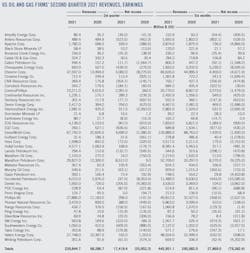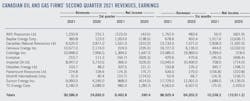Second-quarter earnings improve on higher commodity prices
A sample of 45 US-based oil and gas producers and refiners recorded a collective net income of $17.42 billion for second-quarter 2021, compared to a combined loss of $35.95 billion for second-quarter 2020. Total revenues were $240 billion for the quarter, compared to $99.29 billion a year ago.
During second-quarter 2021, the availability of vaccines around the world improved and business activity increased. Crude oil and refined product realizations for second-quarter 2021 increased significantly compared to the prior year’s second quarter, which reflected the impact of the unprecedented decline in transportation fuel demand, due to the impacts of the COVID-19 pandemic, and the increase in OPEC+ crude supply. In addition to higher commodity prices, the companies’ financial performance also was helped by the absence of huge impairments seen a year ago.
Brent crude oil prices averaged $68.83/bbl in second-quarter 2021, compared with $29.34/bbl in second-quarter 2020 and $60.82/bbl in first-quarter 2021. West Texas Intermediate (WTI) averaged $66.1/bbl in second-quarter 2021, compared with $27.81/bbl in second-quarter 2020 and $57.79/bbl in first-quarter 2021.
For second-quarter 2021, US crude oil production averaged 11.22 million b/d, compared to 10.68 million b/d in second-quarter 2020, according to the US Energy Information Administration (EIA). US natural gas liquids (NGL) production averaged 5.44 million b/d during the quarter, compared to 4.96 million b/d a year ago.
Companies’ drilling activities remained curbed by capital disciplines. According to Baker Hughes, the number of active oil rigs in the US increased to 376 at end June from 324 at end March. This compared to 188 rigs at the end of June 2020.
US commercial crude oil stock at end June was 445 million bbl, compared to 531 million bbl at end June in the previous year’s second quarter and a 5-year average of 482 million bbl.
For second-quarter 2021, US refinery inputs were 16.16 million b/d, compared with 13.65 million b/d for the same period a year ago. Refinery utilization rate was 89.1%, compared to 72.8% in second-quarter 2020.
According to Muse, Stancil & Co, refining cash margins in second-quarter 2021 averaged $17.4/bbl for Middle-West refiners, $14.36/bbl for West Coast refiners, $8.45/bbl for Gulf Coast refiners, and $7.12/bbl for East Coast refiners. In the same quarter of 2020, these refining margins were $3.58/bbl, $4.14/bbl, $2.04/bbl, and $1.48/bbl, respectively.
Henry Hub natural gas spot prices averaged $2.94/MMbtu in second-quarter 2021, compared to $1.71/MMbtu a year earlier, while US dry gas production for the quarter ramped up to 92.5 bcf/d from 89.7 bcf/d a year earlier, according to EIA data.
A sample of 12 companies based in Canada, including oil and gas producers and pipeline operators, reported total earnings of $6.49 billion (Can.) in second-quarter 2021. In second-quarter 2020, the group’s collective earnings were $240 million.
Western Canada Select (WCS) at Hardisty averaged $54.6/bbl for second-quarter 2021, and $16.35/bbl for second-quarter 2020, respectively. The WTI/WCS differential averaged around $11.45/bbl for second-quarter 2021, compared to around $11.47/bbl in the same period of 2020.
US oil and gas producers
ExxonMobil reported a net income of $4.7 billion for second-quarter 2021, compared to a net loss of $1.1 billion in second-quarter 2020. Second-quarter capital and exploration expenditures were $3.8 billion, bringing first-half 2021 to $6.9 billion, which is consistent with planned lower activity in the first half of the year.
Oil-equivalent production in the second quarter was 3.6 million b/d, down 2% from second-quarter 2020, driven by increased maintenance activity. Excluding entitlement effects, divestments, and government mandates, oil-equivalent production increased 3%, including growth in the Permian and Guyana. During the quarter, production volumes in the Permian averaged 400,000 boe/d, an increase of 34% from second-quarter 2020.
On the downstream side, industry fuels margins improved from the first quarter but remained on the low end of the historical range. Lubricants delivered strong performance, underpinned by lower operating expenses, and improved margins.
Chevron Corp. recorded net earnings of $3 billion for second-quarter 2021, compared to a net loss of $8.3 billion for second-quarter 2020. Adjusted earnings of $3.3 billion in second-quarter 2021 compares to an adjusted loss of $2.9 billion in second-quarter 2020.
Chevron’s worldwide net oil-equivalent production was 3.13 million b/d in second-quarter 2021, an increase of 5% from a year ago. Upstream reported earnings of $3.18 billion in second-quarter 2021 compared with a loss of $6.1 billion in the corresponding 2020 period.
Downstream reported earnings of $839 million in second-quarter 2021 compared with a loss of $1.01 billion in the corresponding 2020 period, primarily due to higher margins on refined product sales, higher equity earnings from 50%-owned Chevron Phillips Chemical Co. LLC (CPChem), and higher sales volumes.
ConocoPhillips announced a net income of $2.1 billion for second-quarter 2021, up from net earnings of $260 million in second-quarter 2020. Excluding special items, second-quarter 2021 adjusted earnings were $1.7 billion, compared with a second-quarter 2020 adjusted loss of $1 billion. Special items for the current quarter included a gain on Cenovus Energy shares and a contingent payment from Cenovus associated with the 2017 Canadian disposition, partially offset by corporate expenses.
Production excluding Libya for second-quarter 2021 was 1.55 million boe/d, an increase of 566,000 boe/d from the same period a year ago. After adjusting for closed acquisitions and dispositions as well as impacts from the 2020 curtailment program, second-quarter 2021 production increased 3% from the same period a year ago. This increase was primarily due to new production from the Lower 48 and other development programs across the portfolio, partially offset by normal field decline.
EOG Resources Inc. announced a net profit of $907 million for second-quarter 2021, compared to a net loss of $910 million in second-quarter 2020. Total company crude oil production of 448,600 b/d was above the high end of the guidance range and 4% more than first-quarter 2021, which was impacted by adverse weather.
Devon Energy Corp. announced net earnings of $256 million for second-quarter 2021, up from a net loss of $670 million in second-quarter 2020. Devon Energy’s oil production averaged 291,000 b/d in the second quarter, exceeding midpoint guidance. This better-than-forecasted volume performance was driven by strong well productivity from the company’s Delaware basin operations.
Pioneer Natural Resources reported second quarter net income of $380 million. Excluding the effects of noncash mark-to-market adjustments and certain other unusual items, non-GAAP adjusted income for the second quarter was $629 million. Cash flow from operating activities for the second quarter was $1.5 billion. During second quarter, Pioneer placed 157 horizontal wells on production. The company’s second-quarter oil production averaged 363,000 b/d, in the upper half of guidance.
US independent refiners
HollyFrontier Corp. reported second-quarter 2021 net earnings of $168.9 million, compared with a net loss of $176.7 million for the prior year’s quarter. Adjusted net income for the current quarter was $143 million compared to adjusted net loss of $40.8 million for second-quarter 2020.
Refining segment pre-tax income was $250.1 million for second-quarter 2021 compared to a pre-tax loss of $5.1 million in second-quarter 2020. This increase was driven by stronger product demand, which resulted in a consolidated refinery gross margin of $11.71/bbl, a 45% increase compared to $8.08/bbl for second-quarter 2020. Crude oil charge averaged 416,350 b/d for the quarter compared to 312,070 b/d for second-quarter 2020.
Marathon Petroleum Corp. posted net earnings of $8.5 billion for second-quarter 2021, up from a net income of $9 million in second-quarter 2020. Adjusted net income was $437 million for second-quarter 2021. This compares to an adjusted net loss of $868 million for second-quarter 2020. Adjusted results for these periods exclude net pre-tax benefits of $11.6 billion and $1.4 billion, for second-quarter 2021 and second-quarter 2020, respectively.
The company’s refining and Marketing (R&M) segment income from operations was $224 million in second-quarter 2021, compared with a loss of $1.5 billion for second-quarter 2020. Segment adjusted EBITDA was $751 million in second-quarter 2021, versus a negative $919 million for second-quarter 2020. The increase in R&M earnings was primarily due to higher crack spreads in all regions. Additional benefits were from higher throughput and reduced operating expenses, partially offset by narrower crude differentials.
Phillips 66 announced a net profit of $296 million for second-quarter 2021. The company’s refining had an adjusted pre-tax loss of $706 million in second-quarter 2021, compared with an adjusted pre-tax loss of $1 billion in the first quarter. The improvement was primarily due to lower utility and turnaround costs and higher volumes, partially offset by lower realized margins. Second-quarter realized margins were lower, as the benefit of improved market crack spreads was more than offset by higher RIN costs, lower electricity sales in the Texas market, decreased secondary product margins, lower clean product differentials, and inventory impacts.
Pre-tax turnaround costs for the second quarter were $118 million, compared with first-quarter costs of $192 million. Crude utilization rate was 88% in the second quarter, up from 74% in the first quarter. Clean product yield was 82% in the second quarter, unchanged from the first quarter.
Valero Energy Corp. reported a net profit of $162 million for second-quarter 2021, down from net earnings of $1.25 billion in second-quarter 2020. Second-quarter 2021 adjusted net income was $197 million, compared to an adjusted net loss of $504 million in second-quarter 2020. Second-quarter 2020 adjusted results exclude the benefit from an after-tax lower of cost or market (LCM) inventory valuation adjustment of $1.8 billion.
Valero’s refining segment reported $361 million of adjusted operating income for second-quarter 2021, compared to an adjusted operating loss of $383 million in second-quarter 2020. Refinery throughput volumes averaged 2.8 million b/d in second-quarter 2021, which was 514,000 b/d higher than second-quarter 2020.
Valero’s renewable diesel segment, which consists of the Diamond Green Diesel (DGD) joint venture, reported $248 million of operating income for second-quarter 2021, compared to $129 million for second-quarter 2020. Renewable diesel sales volumes averaged 923,000 gallon/day (gal/d) in second-quarter 2021, 128,000 gal/d higher than second-quarter 2020.
Canadian firms
All financial figures are presented in Canadian dollars unless noted otherwise.
Suncor Energy announced net earnings of $868 million for second-quarter 2021, compared to a net loss of $614 million for second-quarter 2020. The company’s total upstream production increased to 699,700 boe/d in second-quarter 2021, compared to 655,500 boe/d in the prior year quarter, reflecting strong oil sands operations production during the quarter, partially offset by the impact of planned turnaround maintenance at Syncrude. The prior year quarter was impacted by the significant decline in crude oil demand due to the impacts of the COVID-19 pandemic.
Suncor’s refinery crude throughput was 325,300 b/d and refinery utilization was 70% in second-quarter 2021, compared to refinery crude throughput of 350,400 b/d and refinery utilization of 76% in the prior year quarter, reflecting planned turnaround activities in second-quarter 2021 and reduced rates in response to lower demand in the prior year quarter.
Cenovus Energy announced second-quarter 2021 net income of $224 million, compared with a net loss of $235 million in the prior year quarter. Total production of nearly 770,000 boe/d despite planned turnarounds at several assets, and strong realized commodity prices in the upstream business along with continued recovery of demand for US downstream products drove Cenovus’s improved financial performance, which the company expects will continue through the rest of the year.
Imperial Oil announced a net profit of $366 million for second-quarter 2021 as compared to a net loss of $526 million for second-quarter 2020. Production averaged 401,000 boe/d, up from 347,000 boe/d in the same period of 2020. Increased production was driven by strong operating performance as well as the absence of prior year production balancing in-line with market demand. Quarterly production represents the highest second-quarter production in over 25 years.
Imperial Oil’s refinery throughput averaged 332,000 b/d, up from 278,000 b/d in second-quarter 2020. Capacity utilization was 78%, up from 66% in second-quarter 2020. Strathcona refinery completed a major planned turnaround during second-quarter 2021. Subsequent to the turnaround, overall refinery capacity utilization increased to 93% in the month of June.
Canadian Natural Resources reported net earnings of $1.551 billion and adjusted net earnings from operations of $1.480 billion for second-quarter 2021, a significant increase from 2020 second-quarter levels.
The company’s quarterly liquids production volumes averaged 872,718 b/d in second-quarter 2021, decreases of 5% and 11% from second-quarter 2020 and first-quarter 2021 levels respectively, primarily because of the timing of the planned turnaround at Horizon and decoking at Scotford completed in the quarter. Natural gas production averaged 1.62 bcfd in second-quarter 2021, an increase of 10% from second-quarter 2020 levels and comparable with first-quarter 2021 levels.
With the increased positive outlook for commodity prices for the remainder of 2021, Canadian Natural Resources increased its 2021 capital budget by $275 million to $3.48 billion. Year to date, the company has completed three opportunistic acquisitions.
About the Author
Conglin Xu
Managing Editor-Economics
Conglin Xu, Managing Editor-Economics, covers worldwide oil and gas market developments and macroeconomic factors, conducts analytical economic and financial research, generates estimates and forecasts, and compiles production and reserves statistics for Oil & Gas Journal. She joined OGJ in 2012 as Senior Economics Editor.
Xu holds a PhD in International Economics from the University of California at Santa Cruz. She was a Short-term Consultant at the World Bank and Summer Intern at the International Monetary Fund.
Laura Bell-Hammer
Statistics Editor
Laura Bell-Hammer is the Statistics Editor for Oil & Gas Journal, where she has led the publication’s global data coverage and analytical reporting for more than three decades. She previously served as OGJ’s Survey Editor and had contributed to Oil & Gas Financial Journal before publication ceased in 2017. Before joining OGJ, she developed her industry foundation at Vintage Petroleum in Tulsa. Laura is a graduate of Oklahoma State University with a Bachelor of Science in Business Administration.



